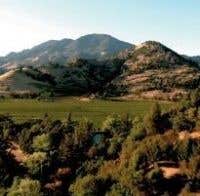After six years, thousands of public comments, vociferous debate and some hard feelings, Chateau Montelena, Araujo, Clos Pegase and other Calistoga wineries will be able to include that place of origin on their labels. An important principle concerning the establishment and use of American Viticultural Areas (AVAs) has also been established.
The Alcohol Tax and Trade Bureau (TTB) this week approved the Calistoga AVA, a process that began in 2003 and stalled when two small brands complained, creating an uproar in wine country and a fundamental re-examination of TTB’s policies for the establishment of federally approved viticultural areas. Finally, the agency has sorted things out, creating Calistoga as the fifteenth AVA within the greater Napa Valley AVA*. The ruling will be published in the Federal Register, probably on 8 Dec, and becomes effective 30 days after that.
In order to state an AVA on a label, at least 85% of the grapes in the wine must be grown within the boundaries of the AVA. (In the US, it has to be at least 85% for AVAs, and 75% for counties and states which are political appellations and not AVAs. So, for example, Sonoma Valley AVA requires 85% whereas Sonoma County requires only 75%; Napa Valley 85% but Napa County 75%. Some states have exceptions, such as Washington state, which requires 95% grapes be from Washington.)
The two brands that opposed the Calistoga AVA, Calistoga Cellars and Calistoga Estate, are not based on grapes grown in the Calistoga area, and say they do not have the means to do so. Under TTB regulations, they cannot have ‘Calistoga’ as part of their brand names because their wines are produced from less than 85% AVA grapes. TTB recognises that to do so could lead to consumer confusion on the origin of the fruit.As Calistoga Cellars and Calistoga Estate begged to keep their business names (neither makes its wines in Napa Valley), AVA petitioners and supporters – among them Napa Valley Vintners, Wine Institute, Sonoma County Vintners, Oregon Winegrowers Association, California Association of Winegrape Growers and Washington Wine Institute – adamantly opposed ‘grandfathering in’ the two wineries, saying to do so would mislead wine buyers and weaken the integrity of viticultural areas, which are intended to delineate winegrowing regions that have distinctive soils, climates and winemaking histories. In the case of Calistoga, it has grown grapes and made wine since soon after the town of Calistoga was founded in 1857.
Several members of the US Congress became involved in the debate, with the majority, led by Senator Mike Thompson (whose father Charlie was the ranch foreman at Stony Hill Vineyard in St Helena), urging the approval of the AVA, without exceptions for Calistoga Cellars and Calistoga Estate. A handful of politicians claimed that the AVA was an enemy of small businesses, although it’s difficult to see Araujo, for example, as anything but small.
One suggested compromise worked its way through more than two years of public comment on the AVA proposal before being put to rest: that Calistoga Cellars and Calistoga Estate put disclaimers on their back labels, stating that the grapes used to make their wines came from elsewhere. TTB was convinced by the argument that consumers don’t always read back labels.
Once the Calistoga appellation is formalised in mid January, Calistoga Cellars and Calistoga Estate will have three years to use up their existing labels and rename their brands.
Specifics on the criteria TTB used to approve the Calistoga AVA, including geological, meteorological and geographical characteristics, and a blow-by-blow account of the marathon approval process, can be viewed here. Chateau Montelena's estate vineyard at the base of Mt St Helena is shown above.
*The other AVAs within the Napa Valley AVA are:
Atlas Peak AVA
Chiles Valley AVA
Diamond Mountain District AVA
Howell Mountain AVA
Los Carneros AVA
Mt Veeder AVA
Oak Knoll District of Napa Valley AVA
Oakville AVA
Rutherford AVA
Spring Mountain District AVA
St Helena AVA
Stags Leap District AVA
Wild Horse Valley AVA
Yountville AVA
See more about the workings of the TTB in today's Great madeira and 'madeira'

